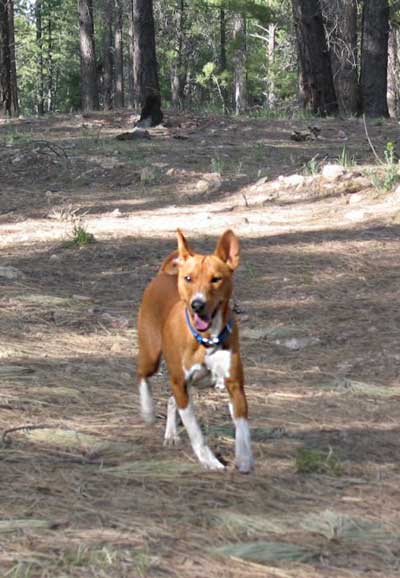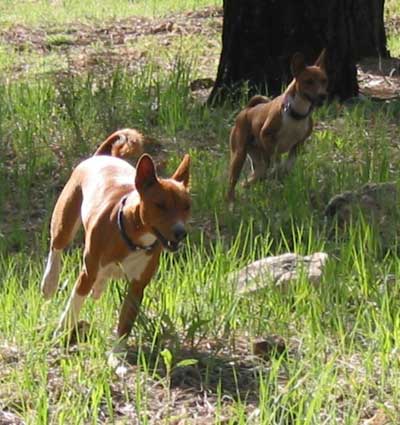Page 5 <Previous Page Next Page>
Sighthound, Scenthound, Soundhound?
by Chris Maxka
Whenever I am at our vacation home in Flagstaff, Arizona, I love to take the dogs to run in the forest. Who wouldn’t…the Coconino National Forest is a quarter mile from the house. For a half hour to an hour, several times a week, I revel in the natural hunting instincts and behaviors of my little pack of Basenjis. Visitors, new dogs, it doesn’t matter. Out in the forest, they all go to work. Their communication and coordination is phenomenal, breaking into pairs or teams, making wide sweeps to the side, reuniting further ahead.
This past year, the American Kennel Club split the Hound Group into two new groups: Sighthound and Scenthound, then asked the Basenji Club of America to poll its members as to in which group the Basenji belongs. I had a lot of trouble with this. A hound is defined as a dog that hunts in a pack, but now we were asked to make distinctions based on HOW that hound hunts, whether it uses the sense of sight, or the sense of smell. I wrote the chair of the AKC committee, inviting him and his committee members to come observe Basenjis in the forest. Of course, there was no time for such an investigation, but I did express my observation that the Basenjis specialize in neither sight nor scent, but use both.
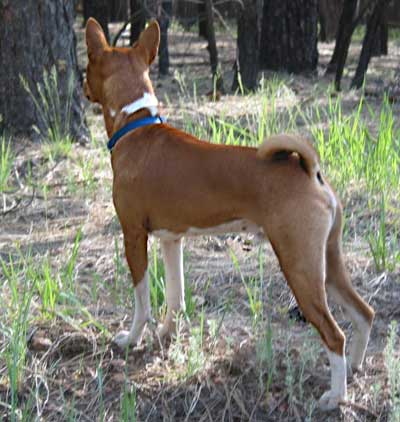 |
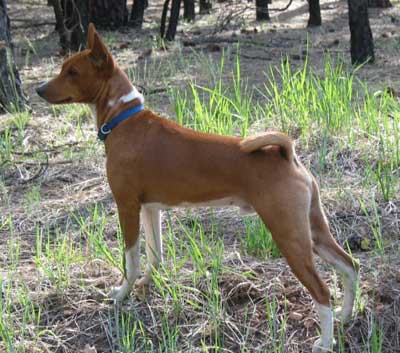 |
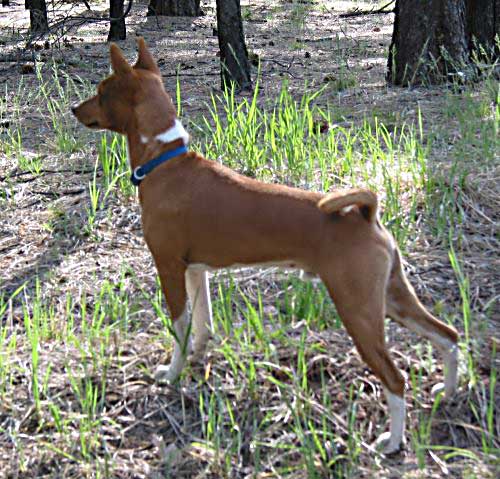 |
We were gone from our forest this summer, but were in Arizona during the early fall, and the dogs were delighted to be out running again. As I accompanied them, something began tickling the back of my head: neither the designation, “sighthound,” nor the designation, “scenthound,” accurately describes Basenji hunting behavior. But neither does the combination of sight and scent. I was musing on this as I watched Chaminade stop, freeze, and look deep into the forest. Yes, her eyes were indeed “far-seeing,” and her nose was delicately, expertly testing the wind, while her ears flicked forward, sideways, and independent of each other…
That was it! The ears. In the forest, my Basenjis use not two, but three senses, constantly, and in exquisite coordination.
The cupped ears rotate independently, like tiny radar dishes, to pinpoint the source of any sound, or towards any flash of movement beyond the trees. When something interesting is located, both ears point directly to the spot, so precisely focused that you could use the ears as the site on your rifle (if you had a rifle). Just as humans use two eyes, spaced an inch apart, to create accurate depth perception, the Basenjis use their ears, spaced an inch apart, to triangulate and precisely locate the source of a sound.
The long, floppy ears of scenthounds cover their ear canals, muffling their sense of hearing. The sighthounds split, with the greyhound, saluki, and Afghan having partially or fully covered ears, while the ears of the Pharaoh Hound and Ibizan are erect like the Basenji. However, the noses of the lofty sighthounds are too high above the ground to do much serious scenting.
The Basenjis have an integrated hunting style that is not fully appreciated, even in lure coursing. In the forest, the dogs make wide sweeps around me, running in a long loping gallop, or break into a swift trot, often with nose to the ground, when on a scent. They frequently stop and spend a few minutes at a particularly interesting scent, gathering around. But just as often, they pause, look, and listen for a few seconds, ears rotating, before dashing off again.
Occasionally something will be particularly interesting, and lead one or two of the dogs off over the hill, just far enough that they lose track of the rest of us. I have seen them on the hill across the valley, running with heads high, ears rotating, searching for some clue as to where we might be. I’ve developed a call that carries far through the forest, and when I use it, I see the ears rotate until both are pointed directly towards me. Even when they cannot see me yet, they turn and race towards me, ears high on the forehead, cupped, pointing to me.
